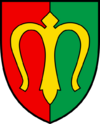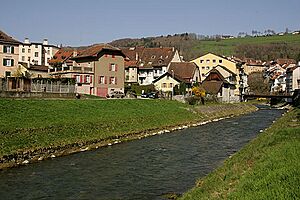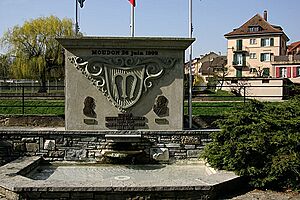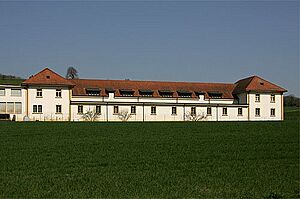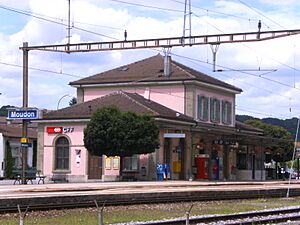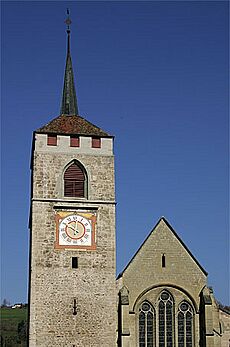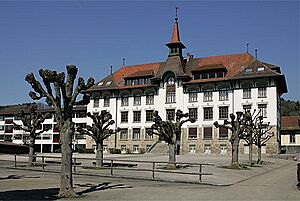Moudon facts for kids
Quick facts for kids
Moudon
|
||
|---|---|---|

Château de Carrouge
|
||
|
||
| Country | Switzerland | |
| Canton | Vaud | |
| District | Broye-Vully | |
| Area | ||
| • Total | 15.65 km2 (6.04 sq mi) | |
| Elevation | 514 m (1,686 ft) | |
| Population
(Dec 2020 )
|
||
| • Total | 6,101 | |
| • Density | 389.84/km2 (1,009.7/sq mi) | |
| Demonym(s) | Les Moudonnois Les Mange-plumes Les Traîne-bailli |
|
| Postal code |
1510
|
|
| Localities | Bressonnaz | |
| Surrounded by | Neyruz-sur-Moudon, Bussy-sur-Moudon, Lucens, Curtilles, Chesalles-sur-Moudon, Chavannes-sur-Moudon, Vulliens, Syens, Rossenges, Hermenches, Sottens, Martherenges, Chapelle-sur-Moudon, Saint-Cierges | |
| Twin towns | Mazan (France) | |
Moudon is a town in the canton of Vaud in Switzerland. It's a charming place with a rich history and beautiful natural surroundings. It used to be the main town of the Moudon District, but now it's part of the Broye-Vully district.
Contents
History of Moudon
Moudon has a very old past. During the time of Roman rule, it was known as Minnodunum or Minnidunum. It was an important stop on a road that connected Viviscus (which is now Vevey) to Aventicum (modern Avenches).
Over the centuries, its name changed a few times. Around the 1100s, people called it Meldun or Meldunum. By 1161, it was already known as Moudon, which is the name we use today.
Geography of Moudon
Moudon covers an area of about 15.69 square kilometers (about 6 square miles). A large part of this land, nearly half, is used for farming. Forests cover about 35% of the area, providing lots of green space. The rest of the land is used for buildings, roads, and rivers.
The town is special because it sits where two rivers, the Mérine and the Broye, meet. The upper part of the town is at this meeting point, and the lower part stretches along the Broye river. Moudon was also important because it was located where two old trade routes crossed. One road went from Italy to Burgundy, and the other connected Geneva and Bern.
Moudon includes the main village and several smaller areas called hamlets, like Plan and Villaret. There are also many old farmhouses scattered around. In the future, Moudon and the nearby town of Rossenges might join together to form one larger municipality.
Moudon's Coat of Arms
The coat of arms for Moudon is quite simple but meaningful. It shows a large golden letter "M" in the middle. The background is split into two colors: red on one side and green on the other.
People of Moudon
Moudon has a population of about 5,678 people. Many different people live here, and about 37.5% of the residents are from other countries.
Most people in Moudon speak French, which is the main language. After French, the next most common languages are Portuguese and Albanian. Some people also speak German or Italian.
Many people who live in Moudon were born there, or in the same canton of Vaud. Others have moved to Moudon from different parts of Switzerland or from other countries around the world.
The population of Moudon has changed over time, as you can see in the chart below:

Important Historical Sites
Moudon has several buildings and places that are very important to Switzerland's history and culture. These are called heritage sites of national significance. They include:
- The Ancien Grenier (Old Granary)
- The Swiss Reformed Church of Saint-Étienne
- The Fountain de Moïse (Moses Fountain)
- The City Hall
- The D’Arnay House
- The États de Vaud House
- The Loys de Villardin House
- The De Rochefort House
- The Tacheron House
- The Castle Tower
These sites are protected because they show the long and interesting history of Moudon.
Twin Town
Moudon has a special friendship with another town, called a twin town.
Economy of Moudon
Moudon has a diverse economy, meaning people work in many different types of jobs. The unemployment rate in 2010 was 6.6%.
Many people work in the tertiary sector, which includes jobs like sales, transportation, hospitality (hotels and restaurants), and services like healthcare and education. This sector has the most businesses in Moudon.
The secondary sector involves manufacturing and construction. This means people work in factories making things or building new structures.
A smaller number of people work in the primary sector, which includes agriculture (farming) and forestry.
Many people who live in Moudon also travel to other towns for work, and many people from other towns come to Moudon to work. Most people use a private car to get to work, but some also use public transportation.
Religion in Moudon
In Moudon, people follow different religions. According to a census from 2000:
- About 33.8% of the population were Roman Catholic.
- About 33.7% belonged to the Swiss Reformed Church.
- There were also people who were Islamic, Orthodox Christian, and members of other Christian churches.
- A small number of people were Jewish, Buddhist, or Hindu.
- About 9.79% of the population said they did not belong to any church, or were agnostic or atheist.
Education in Moudon
Education is important in Moudon. Many adults have completed upper secondary education, which is like high school. Some have gone on to higher education, like university or specialized colleges.
In the Moudon school district, there are hundreds of students. The canton (region) of Vaud provides two years of non-required pre-school for young children. After that, students attend four years of primary school and then six years of lower secondary school. Some students are also homeschooled or attend other types of schools.
Many students who live in Moudon attend schools within the town, but some travel to schools in other municipalities. Similarly, students from nearby towns also come to Moudon for their education.
Transportation in Moudon
Moudon is well-connected by public transport. It has its own [[railway station, Moudon]]. This station is on the Palézieux–Lyss railway line. You can catch regular trains from Moudon to places like Lausanne, Palézieux, Payerne, and Kerzers.
Notable People from Moudon
Many interesting people have come from or lived in Moudon:
- Abraham-Louis-Rodolphe Ducros (1748–1810), a famous painter and engraver.
- Daniel Peter (1836–1919), who invented milk chocolate!
- Eugène Burnand (1850–1921), another talented painter.
- Gabriel Tschumi (1883–1957), who was a Master Chef for British royalty.
- Gustave Roud (1897–1976), a poet and photographer who died in Moudon.
- Philippe Jaccottet (1925–2021), a well-known French-speaking poet and translator.
- Daniel Atienza (1974–), a former professional road bicycle racer from Spain.
Images for kids
See also
 In Spanish: Moudon para niños
In Spanish: Moudon para niños


